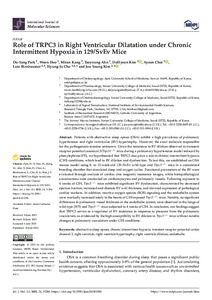Por favor, use este identificador para citar o enlazar este ítem:
https://repositorio.uca.edu.ar/handle/123456789/17375| Título: | Role of TRPC3 in right ventricular dilatation under chronic intermittent hypoxia in 129/SvEv mice | Autor: | Park, Do Yang Heo, Woon Kang, Miran Ahn, Taeyoung Kim, DoHyeon Choi, Ayeon Birnbaumer, Lutz Cho, Hyung Ju Kim, Joo Young |
Palabras clave: | APNEA OBSTRUCTIVA DEL SUEÑO; HIPOXIA CRONICA INTERMITENTE; POTENCIAL RECEPTOR TRANSITORIO CANAL CATIONICO 3; VENTRICULO DERECHO; HIPERTROFIA DEL VENTRICULO DERECHO; DILATACION DEL VENTRICULO DERECHO; ENDOTELINA | Fecha de publicación: | 2023 | Editorial: | MDPI | Cita: | Park, D. Y. et al. Role of TRPC3 in right ventricular dilatation under chronic intermittent hypoxia in 129/SvEv mice [en línea]. International Journal of Molecular Sciences. 2023, 24(14), 11284. doi: 10.3390/ijms241411284. Disponible en: https://repositorio.uca.edu.ar/handle/123456789/17375 | Resumen: | Abstract: Patients with obstructive sleep apnea (OSA) exhibit a high prevalence of pulmonary hypertension and right ventricular (RV) hypertrophy. However, the exact molecule responsible for the pathogenesis remains unknown. Given the resistance to RV dilation observed in transient receptor potential canonical 3(Trpc3)−/− mice during a pulmonary hypertension model induced by phenylephrine (PE), we hypothesized that TRPC3 also plays a role in chronic intermittent hypoxia (CIH) conditions, which lead to RV dilation and dysfunction. To test this, we established an OSA mouse model using 8- to 12-week-old 129/SvEv wild-type and Trpc3−/− mice in a customized breeding chamber that simulated sleep and oxygen cycles. Functional parameters of the RV were evaluated through analysis of cardiac cine magnetic resonance images, while histopathological examinations were conducted on cardiomyocytes and pulmonary vessels. Following exposure to 4 weeks of CIH, Trpc3−/− mice exhibited significant RV dysfunction, characterized by decreased ejection fraction, increased end-diastole RV wall thickness, and elevated expression of pathological cardiac markers. In addition, reactive oxygen species (ROS) signaling and the endothelin system were markedly increased solely in the hearts of CIH-exposed Trpc3−/− mice. Notably, no significant differences in pulmonary vessel thickness or the endothelin system were observed in the lungs of wild-type (WT) and Trpc3−/− mice subjected to 4 weeks of CIH. In conclusion, our findings suggest that TRPC3 serves as a regulator of RV resistance in response to pressure from the pulmonary vasculature, as evidenced by the high susceptibility to RV dilation in Trpc3−/− mice without notable changes in pulmonary vasculature under CIH conditions. | URI: | https://repositorio.uca.edu.ar/handle/123456789/17375 | ISSN: | 1422-0067 | Disciplina: | MEDICINA | DOI: | 10.3390/ijms241411284 | Derechos: | Acceso abierto | Fuente: | International Journal of Molecular Sciences. Vol. 24, No.14, 11284, 2023 |
| Aparece en las colecciones: | Artículos |
Ficheros en este ítem:
| Fichero | Descripción | Tamaño | Formato | |
|---|---|---|---|---|
| role-trpc3-right.pdf | 2,09 MB | Adobe PDF |  Visualizar/Abrir |
Visualizaciones de página(s)
33
comprobado en 27-abr-2024
Descarga(s)
15
comprobado en 27-abr-2024
Google ScholarTM
Ver en Google Scholar
Altmetric
Altmetric
Este ítem está sujeto a una Licencia Creative Commons

